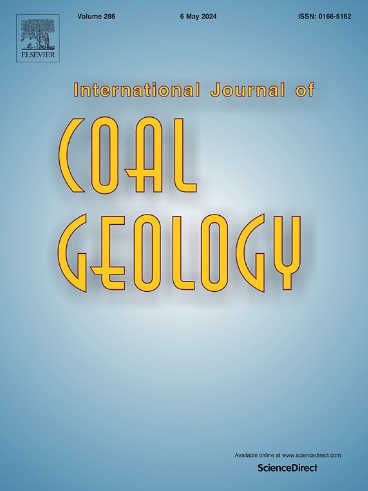Element geochemical characteristics for the roof and floor rocks of coal seams in the Shendong mining area: Emphasis on hazardous element fluorine
IF 5.7
2区 工程技术
Q2 ENERGY & FUELS
引用次数: 0
Abstract
The Shendong mining area produces over 200 million tonnes of coal annually, resulting in notable gangue output, including materials from coal roof, floor and gangue itself. The hazardous elements, particularly fluorine (F), present in the gangues pose challenges for energy utilization and safe use of mine water. Despite this, studies on the elemental geochemical characteristics of gangues in the Shendong mining area are limited. This study collected 19 samples of coal roof and floor and employed methods such as SEM-EDS, XRD, XRF and ICP-MS to analyse the mineral compositions and quantify major-element oxides, rare earth elements and yttrium (REY), and most trace elements. Additionally, fluorine concentration was determined using the alkali fusion–ion selective electrode method. Results indicate that fluorine has the highest average concentration (655 μg/g) among the trace elements, with an enrichment coefficient of 1.21. The major minerals identified in the samples include clay minerals, quartz, and feldspar. The REY distribution patterns in the investigated samples predominantly show L-type enrichment. Combined analysis of B/Ga, Sr/Ba, V/Cr, U/Th, Ni/Co and δU suggest that the coal roof and floor formations occurred in a continental freshwater and oxic sedimentary environment. The material source analysis indicates that coal roof and floor rocks are primarily derived from felsic rocks in the upper continental crust, especially a mixed provenance of granite and calcareous mudstone. Principal component analysis (PCA) reveals that the fluorine primarily exists on the surface of illites in an adsorption state, with Cu, Cs, Se, Th and Rb exhibiting similar states of occurrence. Correlation analyses between fluorine concentrations in the coal roof and floor rocks and parameters of ∑LREY, LaN/LuN, and δCe suggest that fluorine tends to be enriched in weathering residues; additionally, a weakly oxidising environment appears to facilitate fluorine enrichment in these coal roof and floor rocks. The findings in this study can guide the development of effective strategies to reduce fluorine contamination in the mine water; additionally, they aid in developing approaches to address fluorine-related issues during combustion, thereby promoting the safe and efficient utilization of coal gangue as a supplemental fuel resource.
神东矿区煤层顶底板岩石元素地球化学特征——以危险元素氟为重点
神东矿区年煤炭产量超过2亿吨,煤矸石产量显著,包括煤顶、底板和煤矸石本身的材料。脉石中存在的有害元素,特别是氟(F),对能源利用和矿井水的安全使用构成挑战。尽管如此,对神东矿区脉石元素地球化学特征的研究仍然有限。本研究采集了19个煤顶板和底板样品,采用SEM-EDS、XRD、XRF、ICP-MS等方法对样品的矿物组成进行了分析,定量了主要元素氧化物、稀土元素和钇(REY)以及大部分微量元素。另外,采用碱熔离子选择电极法测定氟浓度。结果表明,微量元素中氟的平均浓度最高,为655 μg/g,富集系数为1.21。样品中发现的主要矿物包括粘土矿物、石英和长石。研究样品的REY分布模式主要表现为l型富集。B/Ga、Sr/Ba、V/Cr、U/Th、Ni/Co和δU综合分析表明,煤顶底板形成于陆相淡水-氧沉积环境。物源分析表明,煤顶底板岩主要来源于上陆壳长英质岩,特别是花岗岩和钙质泥岩的混合物源。主成分分析(PCA)表明氟主要以吸附态存在于伊利石表面,Cu、Cs、Se、Th和Rb的赋存状态相似。煤顶底板岩中氟浓度与∑LREY、LaN/LuN、δCe参数的相关性分析表明,氟在风化残余物中有富集的趋势;此外,弱氧化环境有利于氟在煤顶底板岩中的富集。本研究结果可以指导制定有效的降低矿井水氟污染的策略;此外,它们有助于制定解决燃烧过程中与氟有关的问题的方法,从而促进作为补充燃料资源的煤矸石的安全和有效利用。
本文章由计算机程序翻译,如有差异,请以英文原文为准。
求助全文
约1分钟内获得全文
求助全文
来源期刊

International Journal of Coal Geology
工程技术-地球科学综合
CiteScore
11.00
自引率
14.30%
发文量
145
审稿时长
38 days
期刊介绍:
The International Journal of Coal Geology deals with fundamental and applied aspects of the geology and petrology of coal, oil/gas source rocks and shale gas resources. The journal aims to advance the exploration, exploitation and utilization of these resources, and to stimulate environmental awareness as well as advancement of engineering for effective resource management.
 求助内容:
求助内容: 应助结果提醒方式:
应助结果提醒方式:


